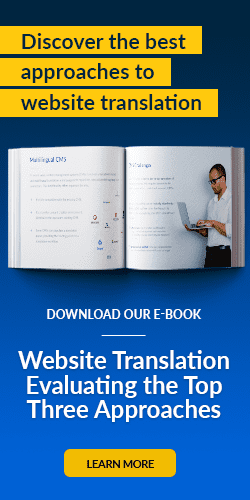As domestic markets become increasingly competitive, companies in all industries are looking to grow in global markets. If your business hasn't yet expanded internationally, there's a lot to consider:
- Which markets are worth pursuing?
- How do you best serve global customers online?
- Are there technical or other challenges that might derail your expansion endeavors?
This quick-start guide will get you thinking about global opportunities—and help you get you in-market, fast.
Identify and Understand Your New Customers
First, identify global markets that represent solid growth opportunities for your business specifically. The best candidate markets are those where customers are already interested in your products or services.
Examine the analytics of your domestic website and note the countries generating most of your international traffic. If you're seeing high bounce rates, it's a sign that customers are seeking information in their preferred language-but are leaving when they can't find it.
Identify growth markets where global customers are already interested in what you provide.
Second, research how potential customers prefer to learn about, order, pay for and receive their products. Some consumers demand a high degree of customer service and will shop elsewhere if they don't receive it, while others are more easygoing.
Some are adventurous about trying new brands, while others respond better to brands with celebrity endorsements.
Third, it’s vital to understand cultural nuances. Brands with a grasp of market fluency—a working knowledge of its cultural identity, local customs, holidays and more—build credibility and trust in new markets quickly.
Speak the Language—And Speak it Well
Twenty years ago, more than 80% of all online users were native English speakers. These days, it's under 25%. It's not a best practice to launch an English-language website in markets where customers prefer to speak another language.
A 2014 Common Sense Advisory study revealed that 75% of global customers prefer to buy in their native language. Another study found that, given the option, 90% of European customers always choose their native language when online.
This study also found that 40% never purchase products and services in other languages.
90% of EU customers always use their native language when online. 40% never buy on sites in other languages.
Content
It’s best to reach these customers in their preferred languages through website translation and localization.
MotionPoint can launch websites in new markets, in users’ preferred languages, in ways that require practically no effort from you. By combining the linguistic and cultural fluency of human translators with innovative technologies, they help businesses connect brands with customers in ways that promote engagement, trust and business growth.
Images and Multimedia
Some of your website's images and multimedia content may feature translatable text. This stuff could include call-to-action banners, sales promotions and coupons. Failing to translate this content will break the immersion of a local site, damage brand authenticity and risk alienating customers.
Translating multimedia content preserves your site’s UX, and eliminates the risk of alienating customers.
Localization
While translation is vital, it will only get you so far. To go farther, your company must transcend translation. Leveraging localization—specific words or phrases preferred in local markets—can be a powerful way to generate customer trust, especially when combined with customized market-specific promotions and offers.
Painless Updates
Another component critical to online globalization is the management of translated, localized content post-launch. Depending on your website's technology stack or CMS, this can be problematic. CMSs often lack the robust features needed to efficiently translate and update complex websites.
Automatic Change Detection
MotionPoint’s fully turn-key proxy solution constantly monitors your flagship website for content changes. When new or edited content is detected, it’s automatically queued for translation. This content is translated typically within one business day, eliminating the effort and expense of manually identifying content and overseeing translation throughout.
MotionPoint translates your website updates typically within one business day—with no effort required on your end.
MotionPoint’s proxy technology doesn’t just translate content hosted on a customer’s “home” servers. It also translates content that lives on third-party servers, and “hidden” content within the code of complex website applications.
If you can view it in a web browser, our solution can translate it.
Flexible and Future-Friendly
MotionPoint also offers an API that allows content integrations between our platform and your e-commerce solution, multilingual CMS, product feeds for virtual marketplaces, etc.
And since it delivers translated content via a secure, independent translation server, MotionPoint's platform integrates well with your current and future technology stacks. It's future-proof, with zero risk of lock-in.
Performance-Boosting Technologies
Finally, as your company expands into new global online markets, remember that website translation, localization, worry-free upkeep, and future-proof technologies are only part of the picture. You'll also want a solution optimized to boost traffic, engagement, and revenue on your global websites.
MotionPoint delivers that, too.
Conclusion
Your company can't not serve online global customers in their preferred languages. Using a digital-first translation agency like MotionPoint can help you engage your international audiences in ways that boost traffic, customer trust and conversions.
Last updated on September 09, 2020